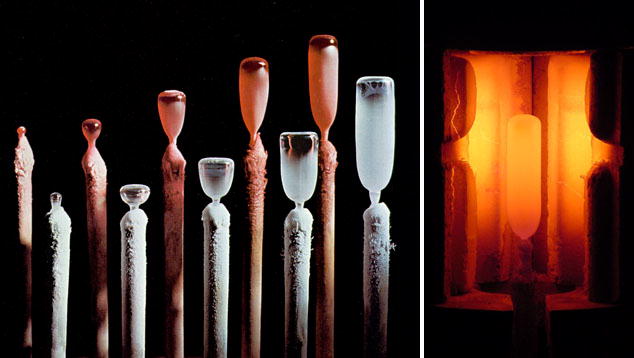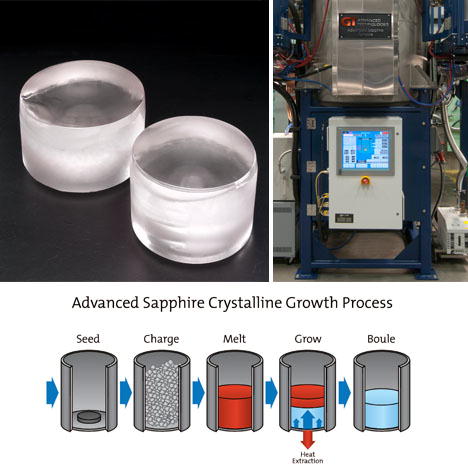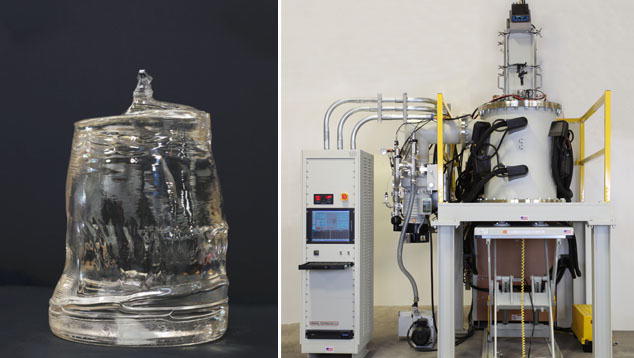Sapphire Series Part 2:
The Next Generation of Sapphire Crystal Growth Techniques
August 6, 2013

Bulk sapphire crystals are industrially produced using various methods and can be summarized broadly as either solution- or melt-grown. Solution growth involves using solvents such as water (hydrothermal) or other chemicals (flux) to create the crystal at a temperature below its melting point. Melt growth is achieved by bringing the Al2O3 all the way to its melting temperature (2040°C) in a crucible. Starting with a specifically oriented seed, a large crystal is formed either by pulling out a portion of the melt or by directionally cooling (gradient freezing) the melt in the crucible. Melt techniques are the focus here, as industry demands large, specifically oriented crystals. We will explore two pulling techniques, two gradient freezing techniques, and one hybrid.
In 1960, the Czochralski growth technique, a method introduced in 1918 that involves rotating and pulling a crystal out of a molten solution in a crucible, was first applied to sapphire. This technique is still very significant today for sapphire and a wide variety of other crystalline materials (including silicon) because it can produce some of the highest-quality crystals in terms of both purity and defects. The quality of these products stems mainly from the precisely controlled growth rate, made possible by carefully adjusting the power required for heating based on a mass-controlled feedback loop. Another factor that makes the Czochralski technique so invaluable is the ability to control the distribution of intentionally added impurities in “doped” crystals. This is accomplished by removing only a fraction of the molten solution rather than freezing the entire melt (figure 2).

Figure 2. A Czochralski-grown synthetic ruby crystal is shown alongside a fabricated piece (left), and during removal from the growth station (right). Photos by Jennifer Stone-Sundberg.
In 1962, the edge-defined film-fed growth technique was first applied to sapphire. This allowed for the production of tubes, sheets, and other highly specified profiles by pulling the sapphire melt through a shaped die. As the demand for protective sapphire windows increases for a wide variety of end uses, this technique will continue to be refined (figure 3). The next part of the series will describe these applications more fully.
Figure 3. Shown here are synthetic sapphire sheet crystals from edge-defined film-fed growth (left) and a growth machine that uses this technique (right). Photos courtesy of GT Advanced Technologies.
In 1964, Khachik Bagdasarov introduced a unique gradient-freeze technique in which the crystal is frozen from one side of the crucible to the other: the horizontal directional solidification method. Prof. Bagdasarov still uses this process to produce sapphire and other crystals. In 1967, Frederick Schmid introduced another gradient-freeze technique, the heat exchanger method, for making large ingots of various crystals (figure 4). This technique has yielded some of the finest optical-quality sapphire and is now owned by GT Advanced Technologies, which produces furnaces based on this technique under the brand name Advanced Sapphire Furnace.

Figure 4. The two crystals on the top left were grown by the heat exchanger method, using the growth equipment pictured on the top right. A schematic of the growth process is shown on the bottom. Courtesy of GT Advanced Technologies.
The Kyropoulos growth method, which combines aspects of both the Czochralski and gradient-freeze techniques, was first applied to sapphire in 1980. Similar to the Czochralski technique, this method involves rotating a seed in contact with the melt, but the crystal is not pulled out of the melt. Instead, the melt inside the crucible is cooled in a very controlled fashion. The Kyropoulos technique has gained widespread use because of its ability to produce extremely large (up to 100 kg) high-quality sapphire crystals (figure 5).
Figure 5. This crystal was grown by the Kyropoulos method, using the equipment shown on the right. Courtesy of GT Advanced Technologies.
Beyond timepiece bearings and scratch-resistant watch faces, what are the high-tech applications of sapphire? These uses, which capitalize on the material’s desirable mechanical, optical, physical, chemical, and structural properties, will be discussed in the third part of this series.
ABOUT THE AUTHOR
Jennifer Stone-Sundberg is managing director at Crystal Solutions, LLC, and a technical editor of Gems & Gemology. She specializes in crystal growth and characterization technology.
.jpg)


